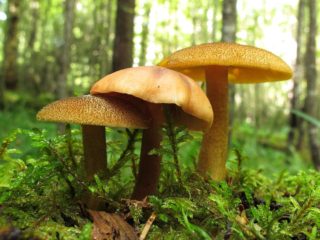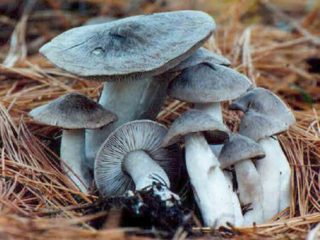Content
Elm row (Hypsizygus elm) is an edible forest mushroom, widespread in temperate latitudes. It is quite easy to identify it, but only after studying the features and false doubles.
Where does Hypsizygus elm grow?
Elm row is characterized by increased cold resistance and therefore grows widely both in the middle zone and in more northern latitudes. Most often, you can see hypsizygus in the forest at the very roots of trees on trunks; it can also grow next to dead wood or on rotting stumps.
The elm row is usually found in groups; you can rarely see it alone. The most favorable time for collection is mid-autumn.
What does an elm row look like?
The appearance of the mushroom is quite characteristic. The cap of Hypsizygus at a young age is convex and turned inward, while in an adult it is spread out and fleshy. The color of the cap is whitish or light beige; the bottom is covered with light, frequent plates. A distinctive feature of the elm row is the presence of “watery” spots on the surface of the cap.
On the stem, hypsizygus rises 4-8 cm, the color of the fibrous stem is identical to the cap or even a little lighter. There is slight pubescence at the base; often the stalk can be curved; in adult mushrooms it is hollow from the inside.
Is it possible to eat Hypsizygus elm?
Although many mushroom pickers are wary of elm mushrooms, they are actually suitable for human consumption. True, the row should not be eaten raw; first it must be boiled for at least 20 minutes.
Taste qualities of mushroom
Elm row is considered a mushroom with average taste. Fresh fruiting bodies are characterized by a mealy taste, characteristic of most rows, but after boiling and subsequent processing it disappears.
Benefits and harm to the body
Eating hypsizygus can provide benefits to human health. The elm row contains important valuable substances, namely:
- polysaccharides;
- essential vitamins A, C, D and B;
- 18 essential amino acids;
- mineral salts;
- digestive enzymes - lipase and amylase;
- glycogen and fiber.
Properly processed hypsizygus increases immune resistance and supplies the body with large amounts of vegetable protein.
Namely:
- accelerates the breakdown of fats;
- helps to lose excess weight;
- helps relieve inflammation in stomach ulcers;
- improves peristalsis;
- has a beneficial effect on skin condition.
At the same time, elm rows can cause serious harm to the body. The protein-rich product is not recommended for use if you have a sluggish intestine - hypsizygus can cause constipation. It is also better to avoid rowing in case of pancreatitis and gastritis with low acidity.
Poisoning from improperly prepared mushrooms poses a great danger. Therefore, pregnant women and children under 7 years of age are prohibited from eating elm row; for them, the consequences of intoxication can be especially serious.
False doubles
Since the appearance of the elm row is quite characteristic, it is difficult to confuse it with other mushrooms. But false doubles of hypsizygus still exist.
Matsutake
An edible mushroom with an unusual name is similar to the elm row mainly in shape; its cap is round at a young age and straightens out over time. You can distinguish the varieties by color - mitsutake has a brown tint with wide spots, and at the edges the cap is whitish and cracked. Its flesh is also white, and its stem is long and club-shaped.
Mitsutake is widespread not only in Japan, as the name might suggest, but also in Europe and North America.In Russia, mitsutake is found in Siberia and the Far East, and active fruiting of the fungus occurs in the same time frame as in hypsizygus - from the beginning of September to October.
Soap row
The conditionally edible mushroom is similar to the elm row in the shape of its cap and size, but in general it is not difficult to distinguish them from each other. The soap row is not beige, but gray or grayish-brown, with a lighter shade at the edges of the cap. If you break the cap, the flesh will quickly turn red when broken.
The soap bar tastes bitter, but it smells like laundry soap. Although the variety is not poisonous, it is not eaten as food - the unpleasant aroma and taste of the soap bar does not disappear during processing, but only intensifies.
Collection rules
It is recommended to collect elm hypsisigus in mid-autumn from the second ten days of September until frost. You need to look for edible mushrooms in forests at the roots of trees or directly on old stumps and dead wood. Since the elm row usually grows in groups, you can collect a fairly large harvest of mushrooms in one trip.
Like all mushrooms, hypsizygus has the ability to absorb toxic substances from soil, wood and air. It needs to be collected only in clean places; you cannot cut fruit bodies growing near roads and industrial areas. Even after processing, too many harmful compounds will remain in their pulp.
Use
Edible forest mushroom is very popular in cooking. A variety of recipes suggest using hypsizygus in salads and soups, main courses and side dishes, and in baking fillings. Elm rows are also pickled and salted, this allows them to preserve their beneficial properties for a long time.
Before any preparation, hypsizygus must be additionally prepared for use. Fresh caps are cleaned, washed in cold water and boiled for at least 20 minutes; processing helps improve taste.
Growing at home
Elm row belongs to the category of mushrooms that are not only collected in the forest, but also grown at home or in the country. This is quite simple to do - you just need to prepare the hypsizygus mycelium, as well as get a good and healthy deciduous log. Mushrooms can be grown indoors throughout the year; in the country, planting should be done from April to October.
The elm row is prepared for planting as follows:
- A birch, aspen or elm log is selected as a nutrient substrate; it should be about 30 cm in diameter and about 50 cm in length. The tree must be taken young, but not younger than 4 years old; the log should not show signs of rotting, branches or any other or defects.
- The log is kept in water for 3 days so that the wood reaches the desired moisture level. After the expiration of the period, the tree is moved to a dry and well-ventilated place for 3-5 days so that excess water comes out of it.
- Using a drill, small indentations about 5-10 cm deep are made in the log, placing them in a checkerboard pattern at intervals.
- The prepared mycelium is placed into the drilled holes using thin, clean sticks. To avoid infecting the hypsizygus seeds with bacteria, sowing should be done with gloves, and the log should be covered with plastic bags immediately after planting the mycelium.
A moistened log with elm row seeds sown inside is transferred to a shaded, well-ventilated place with a constant temperature of at least 20 ° C. While the mycelium develops, the log needs to be moistened from time to time so that the nutrient medium for hypsizygus is maintained.
The development of the elm row mycelium takes about 3 months, sometimes more or less. The first harvest can be seen six months after planting.
Of course, an elm row at home will not be able to grow on the same log for a long time. Soft logs taken from birch, willow or poplar feed the mycelium for about 4 years; on maple, beech and rowan logs the row can grow for up to 7 years. After the yields are reduced, the procedure for planting mushroom seeds will need to be repeated.
Conclusion
Elm row (Elm hypsizygus) is a healthy and pleasant-tasting mushroom with a recognizable appearance. It can not only be collected in the autumn forest, but also grown on your own plot. Hypsizygus reproduces well in artificial conditions.














